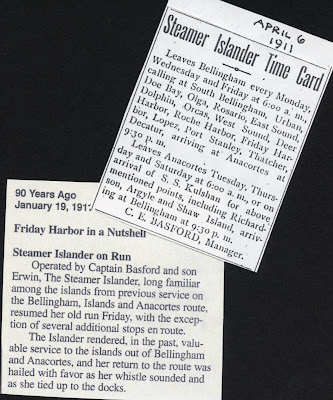 |
The S.S. ISLANDER Built in 1904 by J.A. Scribner at Newhall, Orcas Island, WA. Fate: sold to Mexico. From the archives of the Saltwater People Historical Society© |
 |
Above clips from the Friday Harbor Journal with dates from 1911. |
"In the newly settled San Juan Islands crop movements became a life support system to steamers like the Rosalie and the Islander. Settlers had broken ground on Decatur, Blakely, Stuart, and Waldron Islands, all virtually deserted today but settled enough by 1900 to warrant post offices. Most island crops were grown on the bigger islands: Shaw, Lopez, Orcas, and San Juan, cultivated by homesteaders from Ireland, Germany, Sweden, Norway, Denmark, England, Scotland, and Canada. Others arrived fresh from the worked-out goldfields of California or the riffles of the Fraser River. Captains on vessels loading spars for Falmouth and Brest returned to come ashore and "swallow the anchor." Other island settlers were Civil War veterans [such as Oscar Fowler and Isaiah Jones, the latter the father to San Juan County sheriff Newton Jones] and Midwest farmers beaming at the misty rains.
In 1900, Island County boasted its population had soared 40 percent during the past decade. Stripped of boosterism, that still meant a population of only 3,000. But the newcomers were prodigal producers.
Island apples became as popular as today's harvest from Yakima and Wenatchee, soon to begin bearing fruit and deny the islanders' dreams of becoming the "Apple Basket of America." Wagons rattled their way to island docks laden with fruits, dairy products, grains, and beef and lamb.
By the turn of the century, another bounty—along with the lime mined on San Juan Island—was making its way to market on the steamers. Drawn by the closeby migratory routes of salmon, fish traps, reefnetters, and boatsmen were bringing in a rich harvest. One Friday Harbor cannery alone packed 50,000 cases in a single year.
Vashon Island shipped berries, greenhouse tomatoes, and cucumbers. Steamers stopped to load cases of eggs that were to win national blue ribbons.
On Whidbey Island, Langley and Coupeville docks creaked with movements of provender for Everett and Seattle, including potatoes grown by Chinese farmers and sacks of wheat harvested by Dutchmen who, until soils became depleted, harvested
record-breaking yields of wheat (117 bushels per acre in 1892.)
The San Juan Islanders became the first on the Sound and its ancillary waters to become wedded to the steamer. Most were landlubbers, but they relaxed aboard workhorses like the Islander and the Rosalie.
Islanders had watched some of these being built by their skipper owners on crude ways in a tideland clearing. To the islanders, the steamer was a truck, an ambulance, a school bus, a hearse, and a bearer of mail and visitors. Best of all it was a social hall where, in the warmth of a cabin, coffee could be shared and loneliness melted as the blue-black shores of the islands flowed by."
Jim Faber. Steamer's Wake. Enetai Press, Seattle. 1985.






No comments:
Post a Comment